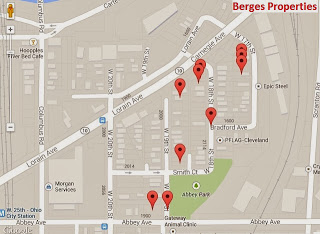If it looks like a big real estate development and sounds like a big real estate development, it probably will be a big real estate development. That’s what a spate of real estate transactions in recent months suggest for an urban enclave close to downtown that’s neither an island or named after ducks. (Some claim it’s named for criminals who used to duck and hide here from the law). It’s an ear-shaped area east of Columbus Road and west of the Walworth Run valley.Duck Island is actually part of Tremont although many people think it’s in Ohio City. The official dividing line for the service areas of the two community development corporations (Ohio City Inc. and Tremont West Development Corp.) is Columbus Road.Duck Island reappeared on my radar Nov. 1 when the city’s Design Review Committee was asked to approve a request by Ward 3 Councilman Joe Cimperman to vacate part of West 20th Street north of Lorain Avenue.Council members don’t just submit requests to vacate city streets when they feel like it. They do so at the request of others. And vacating a city street means the city is relinquishing its right of way, probably forever. It can be a pretty big deal, and it often takes a big project to justify it.
At the north end of West 20th?is a vacant, single-level industrial building that was for sale for years. One year ago, it was acquired by Andrew Brickman. He is a partner with Justin Campbell in Abode LLC which builds eco-friendly, luxury town homes in Cleveland’s University Circle and Little Italy, plus the inner-ring suburbs Cleveland Heights, Fairview Park and Lakewood.
All around Brickman’s industrial parcel are numerous other residential and vacant properties having different corporate owners. Yet all the names trace back to Brickman or Abode in public records. Taken together, the properties west of West 19th/Grove Court Condos and atop the hill east of Columbus Road form a site about as large as the St. Ignatius High School campus (or at least the main campus north of Lorain Avenue).
The purpose of this agglomeration is not a secret. It is revealed in the name of one of the companies formed to acquire land at the north end of Duck Island Abode Ohio City Townhomes, according to records from the Cuyahoga County Auditor’s office.The timing of this project is less well known; Brickman isn’t talking publicly about this project yet. However, considering that the city is already vacating a street for it, this strongly suggests that demolitions and site preparation could be sought soon. How many demolitions? Four commercial structures are probable; but there are also 14 historic houses sprinkled in this area and most appear to be in fair to good condition. Their fates are unknown.
What is known are the intentions of the developer eyeballing the area of Duck Island south of Lorain Avenue. About 20 properties, most of them vacant land, were acquired by Matt Berges or his company Berges Home Performance. Ten of them are for development of green-friendly infill housing.

Plans for various housing styles and property locations
are shown on his firm’s Web site. Berges’ motivations don’t seem to be limited to the financial returns that normally drive developers. Why? First, he is the green housing manager at Environmental Health Watch. And second, he’s invested in the neighborhood in the ultimate way he and his family moved there.
County records show he recently acquired the large brick home and surrounding 10 parcels of the late Rosemary Vinci. If that name doesn’t ring a bell, her name came up during early investigations of the county’s corruption scandal. Vinci died in 2008 under suspicious circumstances. Her father, James Vinci, a reputed organized crime figure who famously owned Diamond Jim’s in the Flats, was reportedly killed in a mob hit in 1985 to prevent him from testifying in a trial of accused mobsters.
But Rosemary Vinci was better known in the neighborhood for owning strip clubs and ruling the Duck Island Block Club with an iron high heel.?One of her missions was to urge Duck Island residents to acquire a neighboring property and demolish the house on it (if it wasn’t already torn down) to reduce the urban density of the urban neighborhood located just one mile from Public Square. She surrounded her own West 18th Street house by a moat of vacated lands and walls that exuded the kind of exclusive estate one expects in a gated suburban community.
A decade ago, Vinci also led opposition to a mixed-income, high-density residential development next to the Red Line Rapid station along Columbus Road south of Lorain. She claimed the transit- and pedestrian-oriented development would increase traffic but others accused her of fear-mongering against its low-income component.Today, Berges is president of the Duck Island Block Club. He’s a forward-thinking man who’s highly regarded around the country and in Cleveland as a sustainable housing contractor.
With the booming demand by young professionals and empty-nesters for more housing in the urban core, it’s important to have sustainability-minded developers like Brickman and Berges who are in a position to respond. It’s a welcome change from the city’s past when fear and corruption shaped our development policies.
Duck Island’s location between Ohio City and the heart of Tremont makes it an ideal urban development area. Its proximity to the Rapid station and the Lorain-Carnegie Hope Memorial Bridge with its new bikeway/walkway into downtown enhances its drawing power. Hopefully Duck Island’s new-urbanist promise shall be hindered no more.END





